Day 3 of a three day Autumn Migration tour today. It was another bright and sunny morning, with the temperature soaring to a heady 27C, although the wind picked up in the afternoon and it clouded over later. Thankfully, the rain helpfully held off until after we had finished for the day.
Our first destination for the day was going to be Burnham Overy, but as we made our way over there we drove round via some old barns beside the road. Once again, the Little Owl was sunning itself in the window frame, just where we had seen it a couple of days ago. Always a good way to start the day!
We parked at the head of the track which goes out across the grazing marshes and stopped to scan the fields first. A small group of Golden Plovers was tucked down in the middle of one of the fields, well camouflaged in the stubble. A Pheasant was down along the back edge and looking more closely we found several Grey Partridges with it. A Red Kite circled over and flushed all the Golden Plover, which whirled round calling. Small groups of Pink-footed Geese kept flying up from the grazing marshes and heading over us inland to feed.
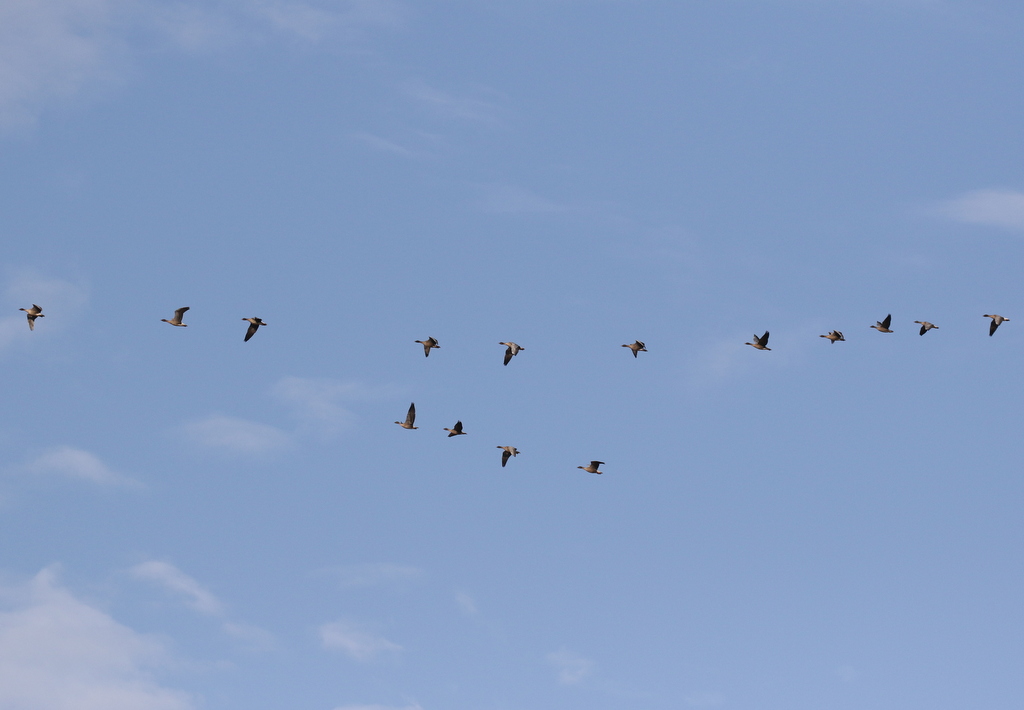
Even from here, we could see a couple of white shapes with the cows way out on the grazing marshes which through the scope we could confirm were Cattle Egrets. We set off down the track for a closer look. A Chiffchaff calling in the hedge popped up onto the top briefly.
What was possibly part of the same covey of Grey Partridges was now on the other side of the hedge, on the edge of the grazing marsh which meant we got a much closer view of them, when they came out from the edge. We heard a Greenshank and a Green Sandpiper calling overhead, but couldn’t see them from where we were on the tree-lined track.
The cows were now at the far side of the grazing marsh, below the seawall. As we got to the end of the track, closer to them, we could see one or two Cattle Egrets. But the cows were feeding around the edge of a reed-fringed pool and some were hidden from view. Gradually more appeared from the vegetation or out of the ditch, until we were sure we could see at least six Cattle Egrets here.
From up on the seawall, we had an even better view. The pool is rapidly drying out and the Cattle Egrets were having great success catching and eating frogs which were revealed in the bottom. It was a bit gruesome, but we watched one throwing its catch around to try to kill it and then swallowing it whole. Some video of the moment is below. Three more of the egrets then also caught themselves frogs just while we were standing there watching.
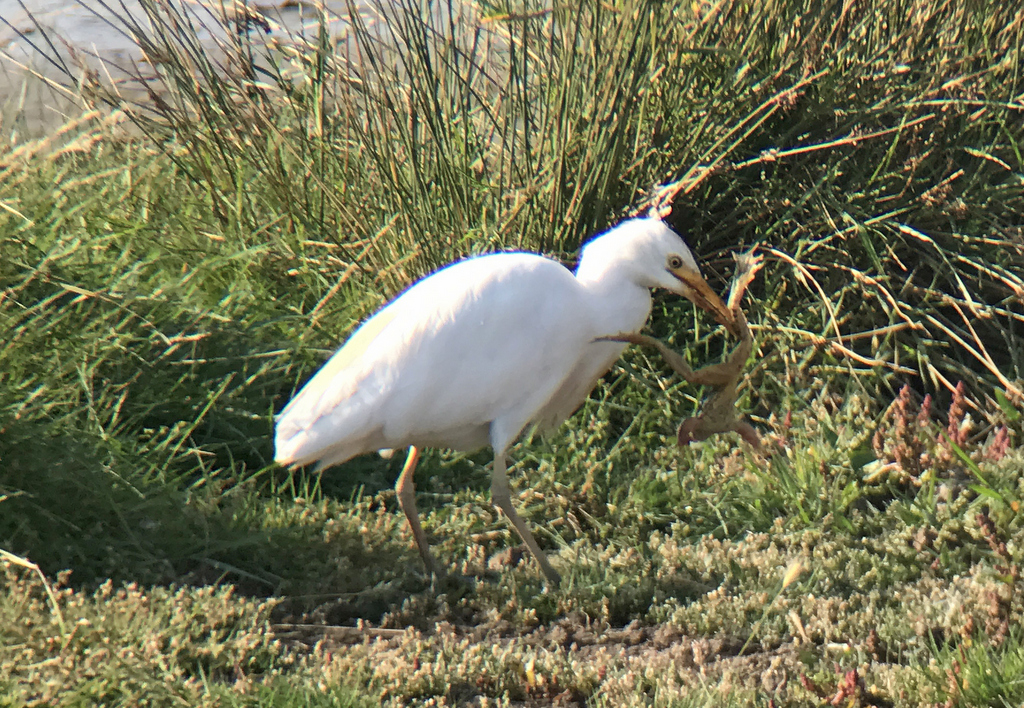
Having watched the Cattle Egrets for a while, we turned our attention to the harbour the other side. There were lots of waders feeding on the mud just below the seawall on our side – mostly Redshanks, but a single juvenile Knot and a few Dunlin were in with them.
Further over, out in the middle of the harbour, we could see a line of Grey Plovers roosting on a sand bar, some of them still sporting the remnants of their summer black bellies and faces. There were also a few Ringed Plovers, Curlews and Bar-tailed Godwits out in the harbour, and a single Sanderling on the sand on our side of the main channel.
There are always hundreds of Brent Geese here through the winter, but they are only just starting to return from their breeding grounds in Russia now. We could see ten distantly out in the harbour. There were several Wigeon along the side of the channel, including one smarter drake already seemingly moulting out of its dull eclipse plumage.
We walked back along the seawall to scan the reedbed pool, which produced a couple of Tufted Ducks and a Little Grebe. We could hear Bearded Tits calling, but they were staying tucked down out of the breeze today. A Kingfisher zipped in over the mud behind us and round over the reedbed, in a flash of electric blue. It carried on right past us and seemed to be heading out across the grazing marsh, but changed its mind and did another fly past back the other way before dropping down into one of the pools in the reeds.
A Marsh Harrier came in over the harbour, flushing all the waders and ducks. It then flew in over the seawall past us, a juvenile with dark chocolate brown body and pale head.
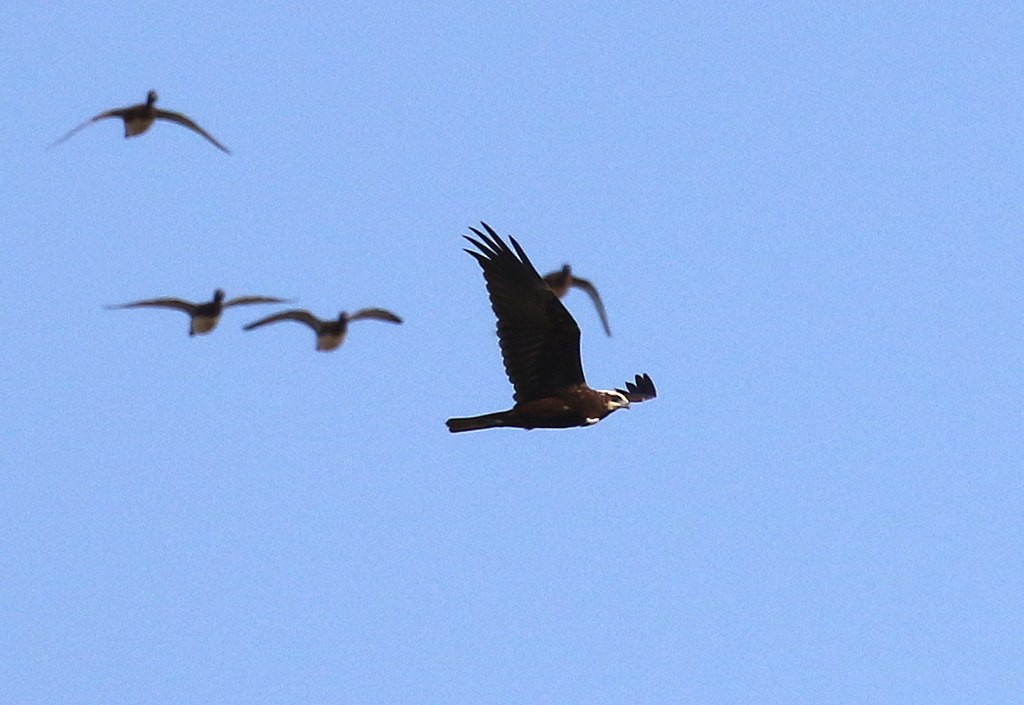
The sound of Pink-footed Geese yelping was a constant backdrop to the morning, with groups coming and going from the grazing marshes. At one point, a large group seemed to have been flushed from the stubble fields inland where they had been feeding and flew back in. We watched as they whiffled down to join the others already in the grass. While we were scanning from here, we spotted two Great White Egrets flying off away from us towards Holkham.
Continuing out to the boardwalk, a small flock of Swallows came overhead and disappeared off east. Looking out the other way, we picked up three Grey Herons flying high west out over Scolt Head. There were obviously still a few birds on the move today. The bushes around the boardwalk were very quiet today, but there was a lot of disturbance with people and dogwalkers coming and going from the beach and dunes. We picked up a distant Whinchat perched on the suaeda out on the saltmarsh, a nice migrant stopping off on its way south.
While standing here, we heard a single short rattling call – a Lapland Bunting. It then went quiet and we didn’t see where it went. However, a couple of minutes later it came back over calling again, a rattle and a sharp ‘teu’. This time we picked it up flying overhead and we watched it as it disappeared away to the west over Gun Hill. Lapland Buntings are scarce winter visitors here in very variable numbers. They were in very short supply last winter, but the early signs are that it might be a good autumn for them so fingers crossed for a better winter this time.
Continuing out through the dunes to Gun Hill, there were several Stonechats in the bushes, and a Whinchat with them. We got a much better view of this one, as it perched on the top of the bushes, flying up trying to catch flies. The Whinchat was noticeably paler than the Stonechats, with a prominent pale supercilium. There were lots of Linnets in the bushes here too.
The tide had come in quickly in the harbour as we had walked out. The sandbar they had been on was under water, and the Grey Plovers were now roosting up on the saltmarsh with several Redshanks. A large flock of Ringed Plovers was on the opposite bank of the channel, and several Dunlin and one or two Turnstone were with them, thought they were constantly getting flushed by the boats sailing back and forth.
It was lovely out in the dunes in the sunshine, looking out over the harbour, but we had a long walk back ahead of us. Back on the seawall, the Pink-footed Geese were very jumpy, not helped by first a light aircraft and then a helicopter coming low over them – surprising there still aren’t better restrictions to prevent disturbance here.

Four Red Kites circled over in the sunshine, as we got back to the reedbed. Down on the track across the grazing marshes several of the Cattle Egrets were feeding with the cows on the short grass by the path now.

When we got back to the minibus, we drove round to Holkham for lunch at the Lookout cafe. After we had recovered from the morning’s walk, we set off west along the track on the inland side of the trees. We could hear Long-tailed Tits calling but they were high in the pines. A Hobby appeared briefly over the tops.
As we got to Salt’s Hole, a Kingfisher zipped across the water at the back and swooped into the trees out of view. There were several Little Grebes out on the water, and they were very active today, chasing each other round, calling like madmen laughing at us. A Jay flew across the back.

We heard more Long-tailed Tits calling behind us and turned to find a couple in the holm oaks. They paused briefly but then zipped through and disappeared into the trees round the side of the pool. More birds followed but frustratingly most didn’t stop – we saw Coal Tit and Chaffinch as they came through, but just heard and caught a glimpse of Goldcrest.
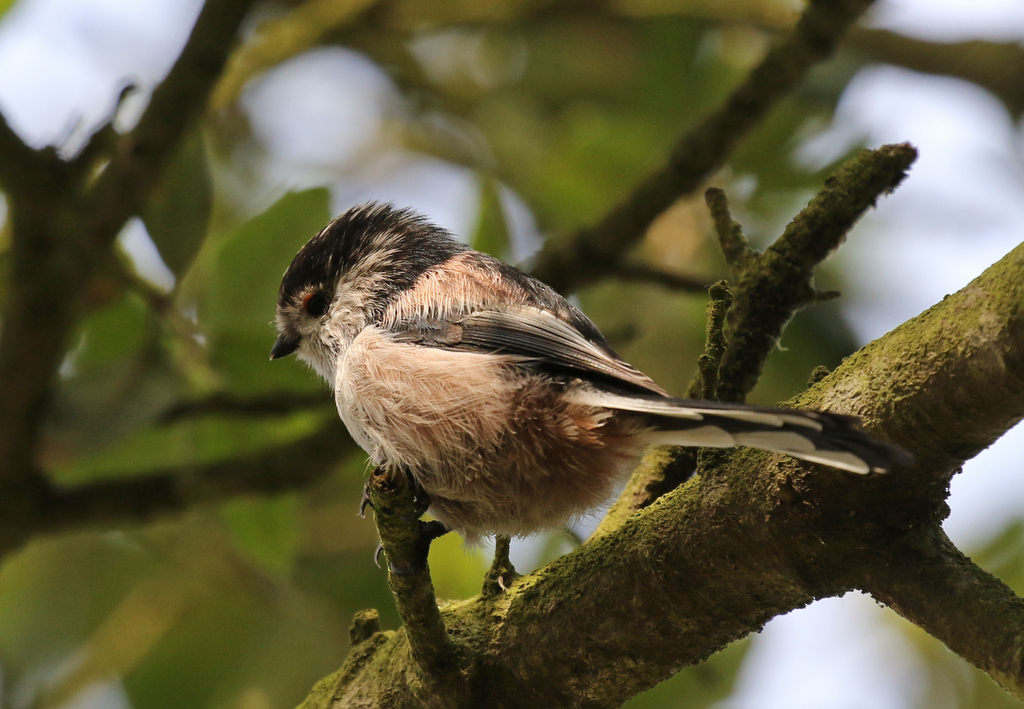
Carrying on along the track, the wind had picked up and the trees were being caught by the breeze once we got out of the shelter of the poplars on the south side of the track. Two juvenile Marsh Harriers circled over the reeds in front of Washington Hide as we walked up but the sycamores behind the hide were quiet. We could hear more tits deep in the trees opposite.
Continuing west, we stopped as another tit flock flew out of the pines by Meals House, but they flew straight through the sycamores and disappeared into the thick holm oaks in the garden. We were hoping to find some migrants with the tits along the track here this afternoon, but it seemed to be a recurring theme that the flocks were not stopping to feed in the deciduous trees by the path, possibly due to the wind.
We were rewarded with good views of a Hobby above the pines, presumably hunting for dragonflies and other insects. It kept coming out into view over the path and then disappearing back over the treetops, circling.
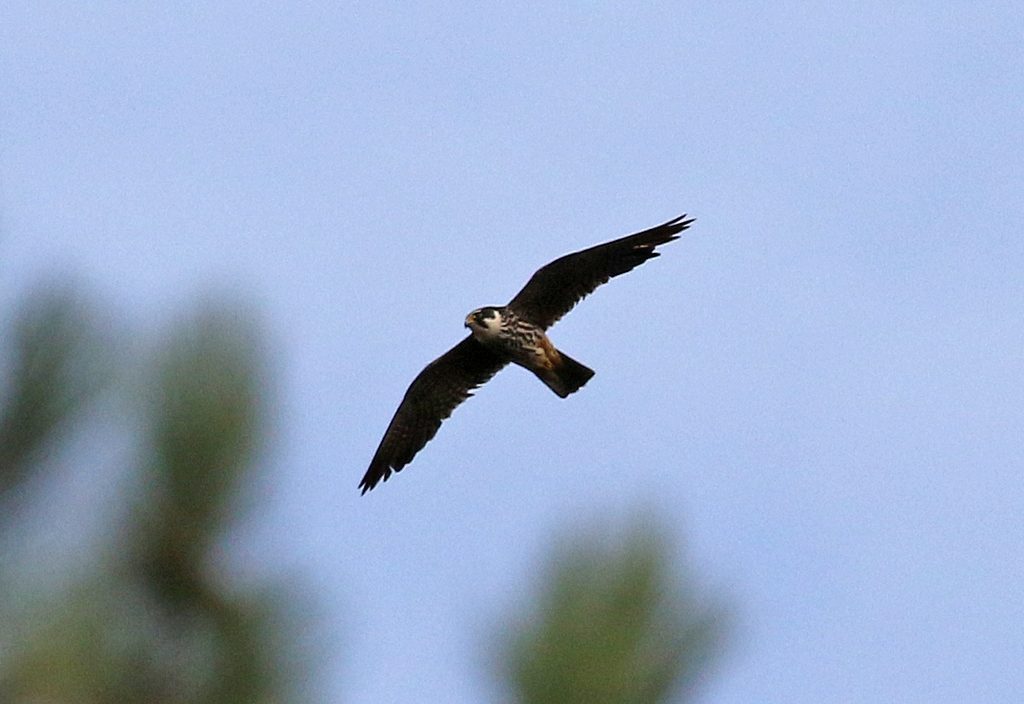
We had a quick look from Joe Jordan Hide. There had apparently been several Great White Egrets on the pool here earlier, but there was no sign of them now. There were plenty of raptors though. A Peregrine flew in and starting chasing pigeons through the trees in Decoy Wood. A Marsh Harrier circled over the grazing marsh and a Red Kite over the park beyond. One of the very pale Common Buzzards was perched in the top of one of the bushes.
The trees just to the west of the crosstracks were less exposed to the wind but still seemed to be quiet, so we decided to try our luck somewhere else. As we walked back along the track, another Red Kite hung over pines where the Hobby had been earlier.
We drove round to Wells Woods for one last roll of the dice, thinking that it might be a bit more sheltered in the trees there. Their seemed to be a fair few migrants turning up fresh in elsewhere along the coast this afternoon – flycatchers and a Yellow-browed Warbler – so we figured there had to be something in the woods along here somewhere. The ice cream van is strategically places by the gate, and we couldn’t resist the temptation – we ate our ice creams as we walked into the trees.
As we walked through the birches it started to cloud over and the wind picked up even more. Some of the trees were being lashed by the breeze now, and we couldn’t find any birds at first. Undeterred, we continued round the Dell, and on the far side we walked into a tit flock. Suddenly there were birds everywhere and we didn’t know where to look.
There were lots of tits – Long-tailed Tits, Blue Tits, Great Tits and Coal Tits. A Goldcrest was flitting around low down in a yew trees, giving us a great look. We heard a Treecreeper calling and first one appeared on the trunk of a tree, then a second flew in behind us and landed low down on a pine, working its way slowly up the side.
Then the flock were off, moving quickly through the birches in the Dell. We tried to follow and it seemed like we might have lost them until we walked into the middle of them again on the bank on the north side of the Dell, more Long-tailed Tits and another nice Goldcrest low down in a bush right above our heads.
A small bird then flew in to the lower branches of a pine above us. It seemed wrong for a Goldcrest and when we looked at it, we could see it was very clean white below. Then it turned its head and flashed its long pale superilium – a Yellow-browed Warbler! It flitted around in the pine for a few seconds, but then as the Long-tailed Tits all flew past into the birches, it followed and we lost sight of it.
The tit flock moved really quickly from there, round the east side of the Dell. We followed, but we just got glimpses of the birds as they flew past us between the trees. Then they seemed to stop for a couple of minutes in the sallows either side of the main path. We tried to find the Yellow-browed Warbler again as the flock crossed the path, but there was no sign of it. All we could find were two Chiffchaffs which stopped to feed in a small oak. Then the flock disappeared through the bushes towards the caravan park, where we couldn’t follow. It would have been nice to see the Yellow-browed Warbler for longer, but at least we had seen it!
It was time to call it a day now and get everyone back.
















